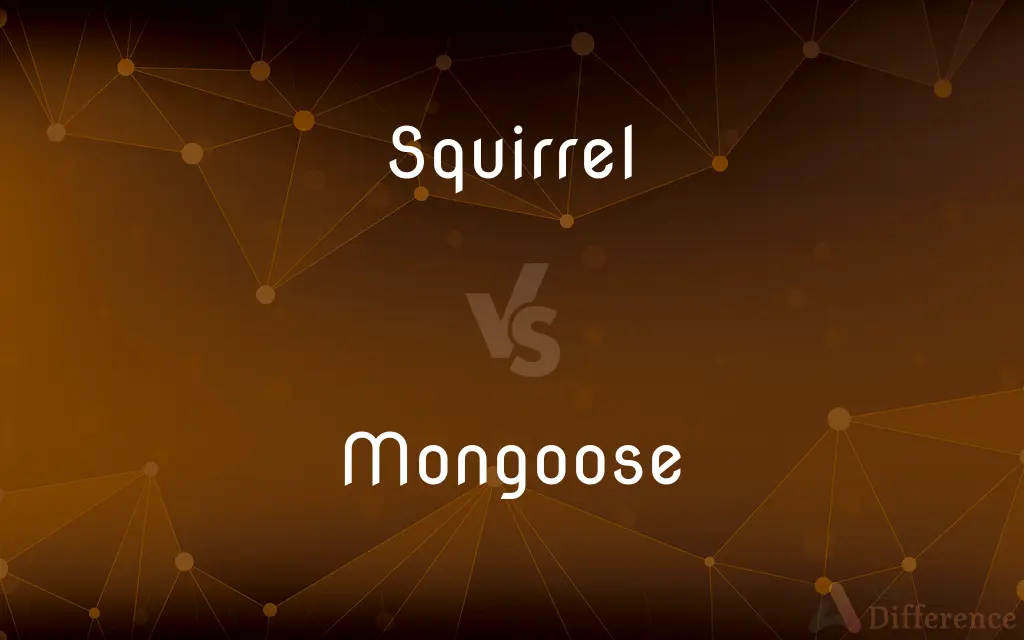Squirrel vs. Mongoose — What's the Difference?
Edited by Tayyaba Rehman — By Fiza Rafique — Updated on March 17, 2024
Squirrels are primarily tree-dwelling rodents known for their bushy tails and nut-gathering habits, while mongooses are agile, carnivorous mammals famous for their snake-fighting abilities.

Difference Between Squirrel and Mongoose
Table of Contents
ADVERTISEMENT
Key Differences
Squirrels are small to medium-sized rodents belonging to the family Sciuridae, known for their long bushy tails and arboreal (tree-dwelling) lifestyle, mainly feeding on nuts and seeds. They are characterized by their sharp claws for climbing and ability to leap between trees. Mongooses, on the other hand, are part of the Herpestidae family, renowned for their agility, elongated bodies, and prowess in hunting snakes and rodents. Unlike squirrels, mongooses are primarily ground-dwelling and exhibit a wide range of dietary habits, from insects to small mammals.
While squirrels have a diverse habitat range, including forests, urban areas, and parks, and are found in various climates from tropical to temperate, mongooses are more commonly associated with warmer climates and are often found in Africa, southern Asia, and southern Europe. Their adaptability to different environments showcases the ecological versatility of each species.
Reproduction in squirrels typically involves simple nests called dreys, with litters ranging from two to eight offspring, depending on the species. Their breeding habits can vary, with some species producing multiple litters per year. Mongooses, conversely, may have more complex social structures that impact their breeding patterns, with some species like the banded mongoose having communal breeding systems.
In terms of human interaction, squirrels are often seen as harmless and even playful in urban and suburban settings, where they can become accustomed to human presence. Mongooses, while beneficial in controlling rodent and snake populations, can sometimes become invasive species outside their native range, impacting local wildlife and ecosystems.
Comparison Chart
Family
Sciuridae
Herpestidae
ADVERTISEMENT
Habitat
Forests, urban areas, parks
Warmer climates, open areas
Diet
Mostly nuts and seeds
Carnivorous, including snakes
Social Structure
Mostly solitary, some species social
Ranges from solitary to social
Interaction with Humans
Often seen as playful, accustomed to humans
Beneficial but can be invasive
Compare with Definitions
Squirrel
Squirrels are known for their habit of gathering and storing nuts.
The nut gatherer busily prepared for winter, stashing away acorns in hidden caches.
Mongoose
Mongooses belong to the Herpestidae family, which is distinct from rodents.
As a Herpestidae family member, the mongoose shared traits with meerkats and civets.
Squirrel
Squirrels play a crucial role in ecosystems by dispersing seeds.
The seed disperser unwittingly planted new trees by forgetting some of its buried acorns.
Mongoose
Unlike squirrels, mongooses spend most of their time on the ground.
The ground-dwelling creature foraged through the underbrush, seeking its next meal.
Squirrel
A squirrel is an arboreal rodent that spends most of its life in trees.
The tree-dweller skillfully navigated the forest canopy, leaping from branch to branch.
Mongoose
In some regions, mongooses have become invasive, negatively impacting local wildlife.
Introduced as an invasive species, the mongoose population upset the ecological balance of the island.
Squirrel
Squirrels belong to the Sciuridae family, which includes various rodent species.
As a Sciuridae family member, the squirrel shared characteristics with chipmunks and marmots.
Mongoose
Mongooses have a diet that primarily consists of meat, including insects, rodents, and reptiles.
The carnivorous mammal pounced on the unsuspecting lizard, securing its dinner.
Squirrel
Characterized by their distinctive bushy tails, squirrels use them for balance and warmth.
The bushy-tailed rodent flicked its tail in irritation as it scampered away.
Mongoose
A mongoose is a small terrestrial carnivorous mammal belonging to the family Herpestidae. This family is currently split into two subfamilies, the Herpestinae and the Mungotinae.
Squirrel
Squirrels are members of the family Sciuridae, a family that includes small or medium-size rodents. The squirrel family includes tree squirrels, ground squirrels, chipmunks, marmots (including groundhogs), flying squirrels, and prairie dogs amongst other rodents.
Mongoose
A small carnivorous mammal with a long body and tail and a grizzled or banded coat, native to Africa and Asia.
Squirrel
Any of various arboreal rodents of the tribe Sciurini and especially of the genus Sciurus, characteristically having a long flexible bushy tail. Also called tree squirrel.
Mongoose
Any of several species of generalist predatory Carnivores in the family Herpestidae; the various species range in size from rats to large cats. The Indian mongoose is noted as a predator of venomous snakes, though other mongoose species have similar habits.
Squirrel
Any of various other rodents of the family Sciuridae, such as the ground squirrels and the flying squirrels.
Mongoose
Any species of pl=s; only distantly related to the Herpestidae, these are members of the family Eupleridae; they resemble mongooses in appearance and habits, but have larger ears and ringed tails.
Squirrel
The fur of one of these rodents.
Mongoose
A species of ichneumon (Herpestes griseus), native of India. Applied also to other allied species, as the African banded mongoose (Crossarchus fasciatus).
Squirrel
To hide or store
Squirreled away her money.
Mongoose
A Madagascan lemur (Lemur mongos).
Squirrel
Any of the rodents of the family Sciuridae distinguished by their large bushy tail.
Mongoose
Agile grizzled Old World viverrine; preys on snakes and rodents
Squirrel
A person, usually a freezoner, who applies L. Ron Hubbard's technology in a heterodox manner.
Squirrel
One of the small rollers of a carding machine which work with the large cylinder.
Squirrel
Someone who displays a squirrel-like qualities such as stealing or hoarding objects.
Squirrel
(transitive) To store in a secretive manner, to hide something for future use
Squirrel
Any one of numerous species of small rodents belonging to the genus Sciurus and several allied genera of the family Sciuridæ. Squirrels generally have a bushy tail, large erect ears, and strong hind legs. They are commonly arboreal in their habits, but many species live in burrows.
Squirrel
One of the small rollers of a carding machine which work with the large cylinder.
Squirrel
A kind of arboreal rodent having a long bushy tail
Squirrel
The fur of a squirrel
Common Curiosities
What do mongooses eat?
Mongooses are carnivorous, eating a variety of prey including insects, rodents, and reptiles.
How do squirrels contribute to the environment?
Squirrels contribute by dispersing seeds, which helps in forest regeneration.
Are squirrels and mongooses related?
No, squirrels are rodents, while mongooses belong to the Herpestidae family.
Can mongooses become pests?
Yes, in some areas where they are not native, mongooses can become invasive pests, harming local wildlife.
Do squirrels hibernate?
Some squirrel species hibernate during the winter, while others remain active year-round.
Do squirrels only live in trees?
While many squirrels are arboreal, some species, like ground squirrels, live in burrows.
Why are mongooses introduced to certain areas?
Mongooses were introduced in some regions to control rodent and snake populations, often with unintended consequences.
How do squirrels communicate?
Squirrels communicate through a variety of vocalizations and tail movements.
What defenses do mongooses have against predators?
Mongooses use their agility, speed, and sometimes group cooperation to defend against predators.
What is the natural habitat of a mongoose?
Mongooses are typically found in warmer climates, in habitats ranging from savannas to forests.
Are mongooses solitary or social animals?
Mongooses vary in social structure, with some species being solitary and others living in groups.
What is the lifespan of a squirrel?
The lifespan of a squirrel can range from a few years in the wild to over a decade in captivity.
Do all mongooses fight snakes?
While many mongoose species are known for their ability to fight snakes, not all engage in this behavior.
Can squirrels remember where they hide their nuts?
Squirrels have a remarkable memory for locating their food caches, though they may forget some.
Share Your Discovery

Previous Comparison
Doctress vs. Doctor
Next Comparison
Babysitting vs. ChildcareAuthor Spotlight
Written by
Fiza RafiqueFiza Rafique is a skilled content writer at AskDifference.com, where she meticulously refines and enhances written pieces. Drawing from her vast editorial expertise, Fiza ensures clarity, accuracy, and precision in every article. Passionate about language, she continually seeks to elevate the quality of content for readers worldwide.
Edited by
Tayyaba RehmanTayyaba Rehman is a distinguished writer, currently serving as a primary contributor to askdifference.com. As a researcher in semantics and etymology, Tayyaba's passion for the complexity of languages and their distinctions has found a perfect home on the platform. Tayyaba delves into the intricacies of language, distinguishing between commonly confused words and phrases, thereby providing clarity for readers worldwide.
















































